For everything you need to know about buying and maintaining tires, click here.
Quick, name the top two safety features on your car, truck, or SUV. Chances are good that tires didn't factor high among the answers. But tires are your vehicle's sole connection to the road. You need to know one of the simplest things you can do to take care of them, so they can take care of you: periodic tire rotation.
"Most drivers don't pay attention to their tires," says Matt Edmonds, executive vice president at the Tire Rack, the largest online marketplace for tire sales in the United States. While tires are his business, Edmonds is under no illusion that tire rotation, a vitally important safety check, is going to get pulses racing.
That's because car tires can seem, well, kind of boring. Most drivers tend not to notice them unless they get a flat. Tires don't have the panache of self-driving technology, the excitement of rubber-burning horsepower, or the feel-good factor of automated emergency braking and blind-spot-monitoring systems.
Too bad, because tire rotation is important when it comes to maintaining the performance and safety of your vehicle. Your tires are, quite literally, where the rubber meets the road, as your tires' contact patches with the pavement are in use during every single drive, in all weather conditions. Well-cared-for tires keep you safe.
Tire Rack
Buy Now
Tire RackTire Rack
Buy Now
Tire RackTire Rack
Buy Now
Tire RackTire Rack
Buy Now
Tire RackDepending on whether the vehicle you're driving is front-, rear-, or all-wheel drive, the tires will wear at different rates. The driven wheels have more work to do and often exhibit quicker rates of wear. A front-wheel-drive car, for example, uses its hard-working front wheels to steer, brake, and put the power down to the pavement (all while carrying the added weight of a front-mounted engine and transaxle).
A front-wheel-drive car, for example, uses its hard-working front wheels to steer, brake, and put the power down to the pavement (all while carrying the added weight of a front-mounted engine and transaxle).
“By rotating your tires, you give the tires a chance to even out their wear and get extended life out of your tires,” Edmonds explains. He recommends having your tires rotated about every 3000 to 5000 miles, or at least every time you go in for an oil change. If your owner's manual states that your car doesn't need new oil that frequently, then plan on a tire rotation at least once every six months.
Rotating your tires evens out the wear and makes them last longer.
Proper rotation not only helps even out wear and extend the life of your tires, it provides the perfect opportunity to make certain all four wheels are in good working order. “As we're coming out of winter and going into spring, it's a good time to inspect the tires' outside and inside shoulder for damage, particularly from potholes,” Edmonds says.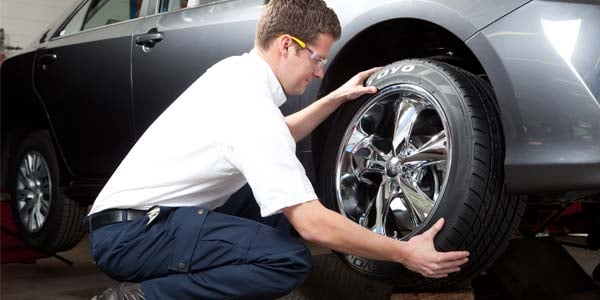 It's also a good time to check the condition of your wheel rims, which can be bent by hard impacts with potholes—sometimes only on the inboard side of the rim, where you can't easily see it.
It's also a good time to check the condition of your wheel rims, which can be bent by hard impacts with potholes—sometimes only on the inboard side of the rim, where you can't easily see it.
Two common tire problems that might surface during an inspection include cupping and blistering of the sidewall.
Getty Images
Tire cupping, Edmonds explains, is more common in older vehicles with suspension systems that are aging and in need of repair. This issue presents itself via uneven wear patterns in the tread, which, if ignored, could significantly affect a vehicle's ride, steering, and braking ability while also wearing out tires prematurely.
A blistered sidewall—literally, a bulge in the sidewall—might result from slamming into a deep pothole. "A tear might occur inside the tire when that tire gets pinched. The air could then get into the structure of the tire, and you get a blister," Edmonds says. If unseen or left undiagnosed, this problem could result in a flat tire or a blowout that could cause a serious accident. We suffered 10 pothole-related tire failures recently with one of our long-term test cars, a 2017 Jaguar XE, over the course of its 40,000-mile stay, due to Michigan's cratered road surfaces.
We suffered 10 pothole-related tire failures recently with one of our long-term test cars, a 2017 Jaguar XE, over the course of its 40,000-mile stay, due to Michigan's cratered road surfaces.
According to the Tire Industry Association, three tire-rotation patterns cover most of today's vehicles, as long as they are fitted with equal-size tires front and rear and those tires are not unidirectional (meaning they have to rotate in only one direction to function properly).
Rotation pattern for front-drive vehicles: Swap the front tires straight to the rear position on the same side. Take the rear tires and move them to the opposite front corner (e.g., the right rear tire gets moved to the left front).
Getty Images
Rotation pattern for rear-drive vehicles: Move the rear tires straight to the front, then move each front tire to the opposite rear corner (for example, move the right front to the left rear).
Rotation pattern for all-wheel-drive vehicles: Crisscross all four tires (move the right front to the left rear, the left front to the right rear, the left rear to the right front, and the right rear to the left front).
By the way, rugged-looking SUVs may be all the rage, but having a vehicle with all-wheel drive doesn't mean you're immune to tire-rotation maintenance. "That is a common misconception," says Edmonds, regarding the idea that all-wheel-drive vehicles automatically have tires that wear more evenly. "All-wheel-drive systems don't always drive all the wheels all the time," he explains, adding that transfer cases and electronically controlled differentials can shift power between the front and rear wheels, depending on the conditions and the drive mode that's been selected. And a vehicle's inherent weight difference between the front and rear can also affect tire wear.
Extra attention needs to be paid when it comes to vehicles with different wheel sizes at the front and rear and those fitted with unidirectional tires—tires that are designed to rotate in one direction only.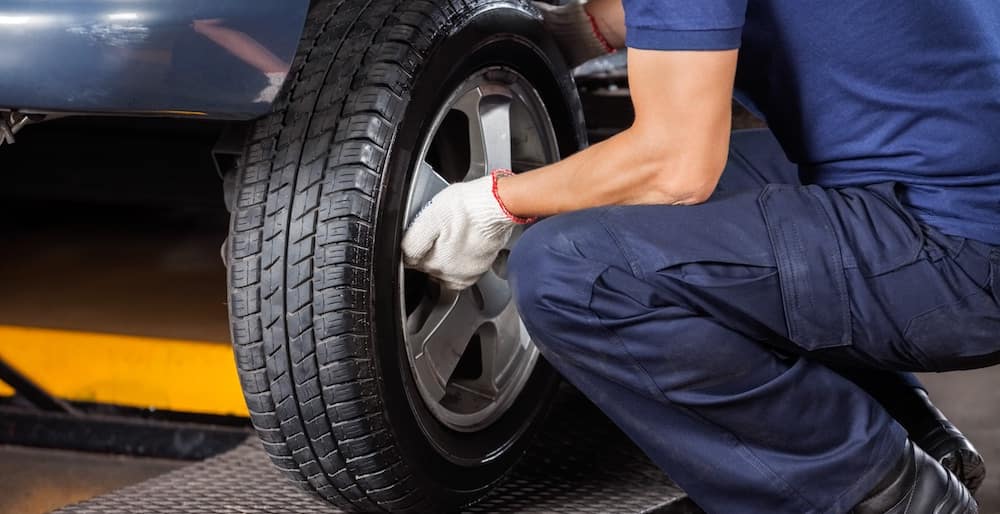 In many cases, this setup is used on high-performance vehicles, and tire-rotation patterns need to be adjusted to suit. In fact, some of these staggered-tire packages, as they are called, cannot be rotated unless the tires are dismounted and then remounted on the opposite-side wheels. In some cases it may not be worth the time, money, or trouble to rotate the tires.
In many cases, this setup is used on high-performance vehicles, and tire-rotation patterns need to be adjusted to suit. In fact, some of these staggered-tire packages, as they are called, cannot be rotated unless the tires are dismounted and then remounted on the opposite-side wheels. In some cases it may not be worth the time, money, or trouble to rotate the tires.
If you have any doubts about correct tire rotation, consult the owner's manual, inquire at a dealership, or talk to an expert who is familiar with your vehicle and its tires. But whatever you do, rotate them if possible. At the very least, it'll help your tires last longer and will save you money.
Now 23% Off
$107 at Amazon
Now 24% Off
$26 at Amazon
Now 28% Off
$59 at Amazon
$70 at Amazon
This content is imported from OpenWeb. You may be able to find the same content in another format, or you may be able to find more information, at their web site.
You may be able to find the same content in another format, or you may be able to find more information, at their web site.
Why should you get your tires rotated? Because it’s one of the easiest ways to extend the life of your tires and get the most miles out of them. And you only need to do it a couple of times a year.
Already know you need a tire rotation? Come visit us at one of our local stores or schedule an appointment.
Rotating the tires on your vehicle means moving them to different positions on your car or truck. This helps promote even tread wear on all four tires.
No matter how you drive, front and rear tires can wear at different rates. Tires that are mounted on the drive axle (the front two wheels on a front-wheel drive or back two on a rear-wheel drive) wear more quickly than the “free rolling” tires on the other axle.
Tires that are mounted on the drive axle (the front two wheels on a front-wheel drive or back two on a rear-wheel drive) wear more quickly than the “free rolling” tires on the other axle.
Properly rotated tires can make for a smoother ride. It can also extend the life of your tires, saving you both time and money. By rotating your tires, you even out the wear to get the most tread life from every tire. Regular rotations are equally important, even if you have an all-wheel drive vehicle.
A good rule of thumb is every 5,000 miles. Depending on your vehicle, driving style, and tire type, you may need to rotate your tires more or less often. If you’re not sure, stop by Les Schwab. We’ll help you come up with a rotation schedule.
Regular tire rotations can help spot uneven tire wear early. Going too long between rotations may result in a wear pattern that can’t be fixed, no matter where the tire is moved on the vehicle. These wear patterns could result in the need for new tires sooner than expected.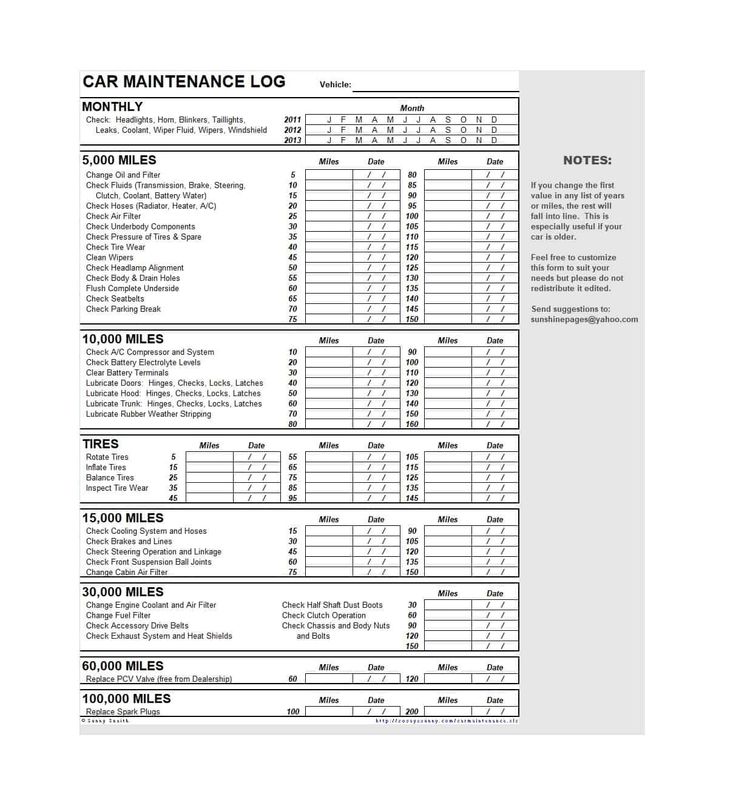
Here are some ways to remember your next rotation.
Getting your tires rotated every 5,000 miles is generally a pretty quick process. The professionals at Les Schwab will take the time to do a thorough tire rotation by also balancing your Les Schwab tires, checking your air pressure, doing a visual check of important safety systems, and documenting anything you should be aware of during the process. Once your vehicle is in our service bays, you can expect this procedure to be completed in about half an hour. Taking the time to make tire rotations a part of your normal vehicle maintenance regimen can add significant life to your tires, promote even tire wear for a smoother and more comfortable ride, and save you money in the long run.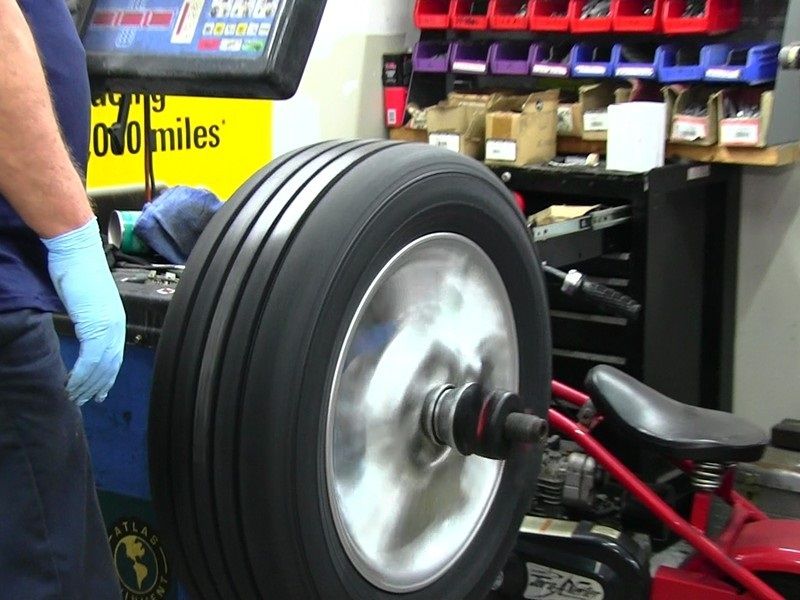
The standard tire rotation is front-to-rear, but there are multiple patterns that could also help promote long tire life.
Here’s what Les Schwab tire pros consider to properly rotate and position the tires on your vehicle.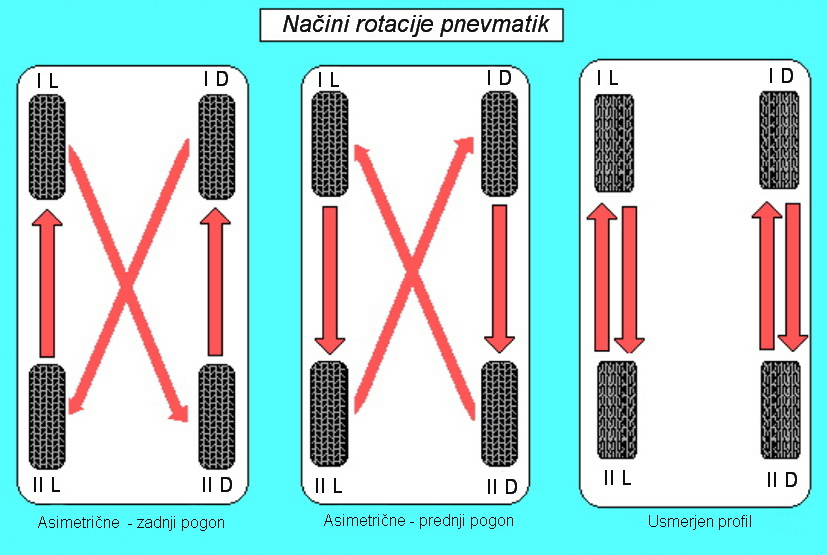
As always, check your owner’s manual for specific recommendations from the manufacturer.
If you have Les Schwab tires on your vehicle, rotations are free for the life of those tires. Plus we balance your wheels as part of the service. Don’t have Les Schwab tires? Our pros can still help maximize the life of your tires. Stop by your local Les Schwab for a quick estimate.
Don’t put tire rotations off. This simple task can maximize the life of your tires. When you buy tires from Les Schwab, we rotate them for free on most vehicles. Plus, we provide free rotation reminders by email. Just ask at your local store.
Just ask at your local store.
The optimum time to change tires seasonally differs from year to year due to quirks of the weather. And this is normal even for one city - what can we say about different regions, where ideas about winter and summer can differ significantly. Therefore, legislative initiatives on forced seasonal “changing of shoes” of cars in strictly defined months look rather strange: nature will still make adjustments.
Here, an analogy with public utilities is appropriate, who start and end the heating season not according to the calendar, but when a certain average daily air temperature is reached - that is, based on the objective readings of the thermometer. The same approach should be followed by motorists when choosing the time to change tires.
The same approach should be followed by motorists when choosing the time to change tires.
At what temperature should tires be changed? Manufacturers believe that +7 degrees Celsius is the optimal moment for seasonal “changing shoes”. At this point, the graphs of grip levels for winter and summer tires converge: at temperatures above +7°C, winter tires work inefficiently and wear out quickly. And at lower temperatures, the performance of already summer tires drops.
But this graph reflects the properties of some average tires. In reality, the composition of the rubber compound for different tires is significantly different. The same winter tires can be both soft "Scandinavian" (hardness 50-55 Shore units), and "Central European", with a hardness of 60-65 units. Obviously, their indicators are very different: the first ones will “float” even with a small plus, the second ones will work tolerably even at +10°C.
Read more: Which tires are best? Scandinavian, European, studded
The choice of temperature is also somewhat arbitrary. In a sharply continental climate, it can be +7 during the day, and -3 at night, and in the morning you will be met by a dangerous ice film on the road. Therefore, it is better to be guided by logic: switch to summer tires when there is no chance of encountering ice on the road. That is, if during the day the thermometer does not go into minus, and the long-term weather forecast does not promise a cold snap. And vice versa, put winter tires before the onset of "near zero" temperatures and the first frosts that threaten to turn puddles into ice.
In a sharply continental climate, it can be +7 during the day, and -3 at night, and in the morning you will be met by a dangerous ice film on the road. Therefore, it is better to be guided by logic: switch to summer tires when there is no chance of encountering ice on the road. That is, if during the day the thermometer does not go into minus, and the long-term weather forecast does not promise a cold snap. And vice versa, put winter tires before the onset of "near zero" temperatures and the first frosts that threaten to turn puddles into ice.
But still, it is the temperature, and not the presence of precipitation, that is the key signal to change tires. For example, at -5°C, summer tires are ineffective even on absolutely dry pavement. And when the temperature rises from +4 to +11°C (just in the region of "transitional" +7°C), the braking distance on winter tires increases by half a meter at once. With a further increase in temperature, winter tires are losing on braking to summer tires for several car bodies. Therefore, driving on winter tires in summer is very fraught.
Therefore, driving on winter tires in summer is very fraught.
Read more: To inform or change shoes? Do I need to change winter tires for summer ones in summer
If you have bought a new set of tires, you can immediately start installing it. But old tires that have been waiting in the wings for six months require certain checks.
First of all, make sure the tires are still serviceable. According to the Rules of the Road, the minimum allowable tread depth for passenger car tires is 1.6 mm (summer tires) and 4 mm (winter tires). With a smaller balance, you can no longer ride on tires.
You can measure the remaining tread with a special tool - a caliper. There are also special wheel tread depth gauges, including digital ones.
Another important traffic law requirement for tires: they must be the same (at least on each of the axles). Modern cars equipped with a lot of smart electronics - ABS, directional stability and braking force increase systems - are even sensitive to uneven tire wear, not to mention different sizes or tread patterns. But the dangerous experiments of drivers with the so-called mixed fleet (sets assembled from different tire models) are already a thing of the past.
But the dangerous experiments of drivers with the so-called mixed fleet (sets assembled from different tire models) are already a thing of the past.
Also, before installation, you need to visually assess the condition of the tires. When stored for a long time, especially in unsuitable conditions (for example, at high humidity, which is not uncommon in private garages), the rubber may deform, crack or dry out. It is impossible to install tires with such defects: at high speed, any crack in the rubber becomes extremely dangerous and threatens to explode the tire.
By the way, for seasonal storage of tires, you can use the “tire hotel Hyperauto”, where the correct temperature and humidity are constantly maintained. Hyperauto specialists bear full financial responsibility for the tires, and on the day you have appointed, they themselves bring the wheels for tire fitting, which is very convenient.
In addition to the tread depth and the absence of external defects, before installing the tires, you need to check their uniform wear (the tire should not be “eaten” from one side), as well as age.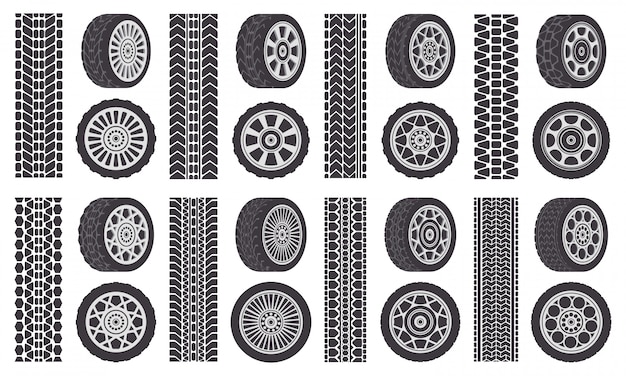 Natural rubber, from which rubber is made, retains its properties for 5 years from the date of manufacture of the tire. The aging of rubber greatly affects the effectiveness of traction, so it’s not worth driving on old, even if not worn, tires.
Natural rubber, from which rubber is made, retains its properties for 5 years from the date of manufacture of the tire. The aging of rubber greatly affects the effectiveness of traction, so it’s not worth driving on old, even if not worn, tires.
When changing tires, do not forget about their periodic rotation - rearrangement, the diagram of which can be found in the instructions for the car. Rearranging the wheels ensures uniform wear, which prolongs the life of the entire set. Standard tire rotation schemes are presented below, but it is better to check the instructions for your particular machine. It is recommended to change tires every 10,000 km.
On rear- and all-wheel drive vehicles, the front tires are moved to the rear axle diagonally (diagram A), or they are changed in a cross pattern (B). On machines with front-wheel drive, the situation is reversed: the rear tires are moved diagonally forward (Diagram C).
Tires with a directional tread pattern cannot be turned without overbeading.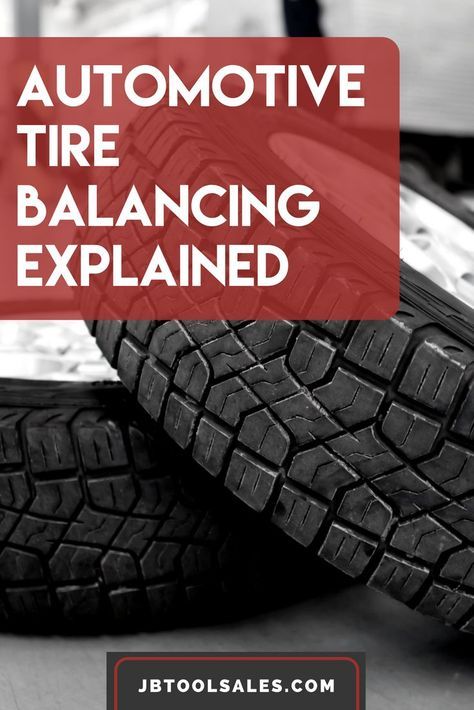 To rotate them without removing them from the disks, the front wheels are simply swapped with the rear wheels on each side of the car (Diagram D).
To rotate them without removing them from the disks, the front wheels are simply swapped with the rear wheels on each side of the car (Diagram D).
If the car is equipped with a full-size spare tire, not a spare tire, and you bought a set of five new tires, be sure to include the "spare" in the rotation (diagrams E and F), changing the wheels every 10,000 km. This will allow you to use the kit longer and easily replace any of the main ones with a spare wheel in case of damage - their wear will be the same. Thanks to this scheme, buying five tires in the end turns out to be more profitable than four, due to longer operation.
To maintain rotation, mark old tires with a colored marker before they are removed from the machine; if you forget about it, then it will be difficult to figure out where which tire was.
In the event that a replacement set of wheels is put on individual discs, check the pressure in them before installing them on the machine.![]() If the tire deflated during storage, look for the reason - the air does not just leave. Under the weight of the car, the air leakage will only intensify, and the next morning after "changing shoes" you will have a flat tire waiting for you if you do not fix it in advance.
If the tire deflated during storage, look for the reason - the air does not just leave. Under the weight of the car, the air leakage will only intensify, and the next morning after "changing shoes" you will have a flat tire waiting for you if you do not fix it in advance.
Do not forget that the pressure in tires of different sizes may differ - do not inflate the old one, getting used to it in six months. Look for recommended pressures for different tire sizes on a sticker in the doorway.
Read more: Tire pressure. How and why to measure it
Do not forget about the importance of wheel balancing: it ensures uniform rotation, the absence of vibrations on the steering wheel and body, and also saves the life of wheel bearings. Balancing is needed for each wheel of the car, including the spare one, in case of emergency installation on the road, as well as for planned tire rotation.
Even if you use two sets of wheels on different rims, check the balance of each set before installing.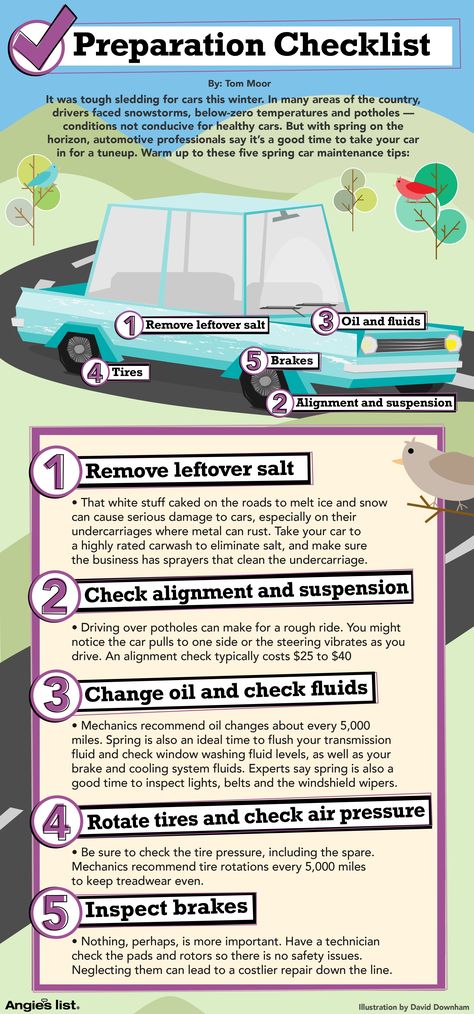 During the season, the tire tread wears out (not always evenly), and the installed weights often fall off - as a result, the wheel balance may be disturbed.
During the season, the tire tread wears out (not always evenly), and the installed weights often fall off - as a result, the wheel balance may be disturbed.
Whenever dismantling the wheels, it is worthwhile to carry out an express inspection of the suspension parts, check the condition of the brake hoses and the thickness of the brake pads. In general, it is useful to combine seasonal tire changes with chassis diagnostics: it is better to identify any unpleasant surprises in advance.
After changing tires, be sure to adjust the wheel alignment (“camber”), because winter and summer tires differ in height and tread pattern, degree of wear; often - dimension and pressure. All these factors disrupt the suspension geometry, which can lead to uneven tire wear, increased fuel consumption, uneven steering wheel position, and vehicle pulls to the side.
Read more: Camber and convergence. When and why to adjust wheel alignment
To avoid these problems, it is better to change tires where you can immediately adjust the camber and toe. For example, in Hyperauto car services equipped with separate tire fitting areas.
For example, in Hyperauto car services equipped with separate tire fitting areas.
A car tire is a rubber elastic shell that is mounted on a disc rim. It is she who is in direct contact with the surface of the roadway and is directly designed to reduce small fluctuations on the roads, as well as to compensate for flaws in the trajectory of the wheels. During operation, it is subjected to heavy loads of a diverse nature, therefore it naturally has its own service life, which is influenced by a number of factors.
Expiration date is the period during which the company guarantees the possibility of using the product for its intended purpose and bears full responsibility for defects that arose through its fault.
When buying tires, you need to look so that no more than three years have passed from the moment of production.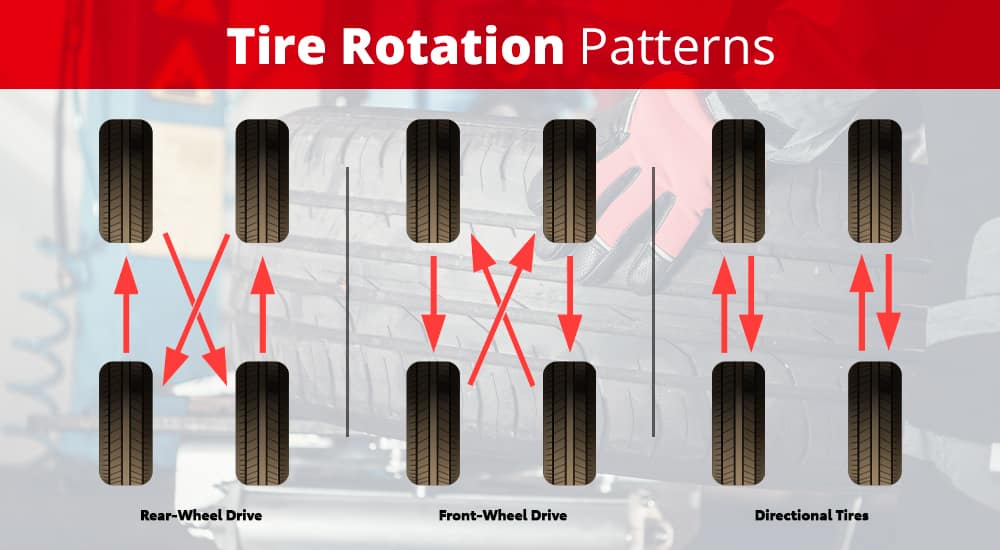 The date of manufacture and any other information is very easy to find out, it is indicated on the tire label among the general information about dimensions, design, speed and load ratings.
The date of manufacture and any other information is very easy to find out, it is indicated on the tire label among the general information about dimensions, design, speed and load ratings.
Tire production date
Russian legislation establishes the service life of car tires under warranty in accordance with GOST 4754-97 and GOST 5513 - 5 years from the date of manufacture, but for tires, first of all, the main indicator is the quality of the product, not time its use.
According to GOST, the average tire life should be calculated in the following order:
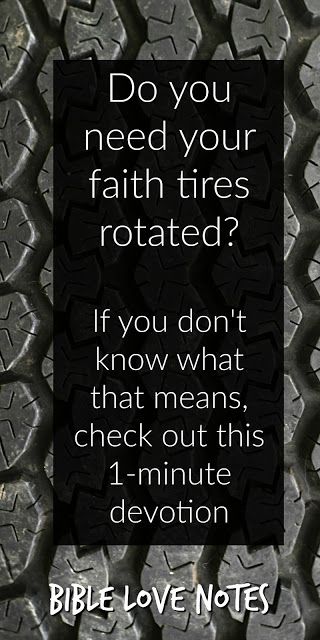
Experts recommend replacing tires before they reach their expiration date. Some motorists believe that rubber is suitable if it is rarely used, and at the same time its age is already 5-6 years old, but this is an erroneous opinion! Indeed, due to the fact that defects appear in tires during operation and storage, they are associated with its oxidation and cracking - at a critical moment, it can let you down.
Shelf life - a certain period during which the goods, subject to the established rules of storage and operation, must retain all their properties. If the shelf life has expired, this does not mean at all that the product is unsuitable for use, but its technical characteristics may decrease.
Tires can age through physical and chemical processes, this hypothesis applies to tires that are not used or little used. To prevent the aging process itself, special substances are added to the rubber compound that help counteract harmful chemical compounds with oxygen and ozone.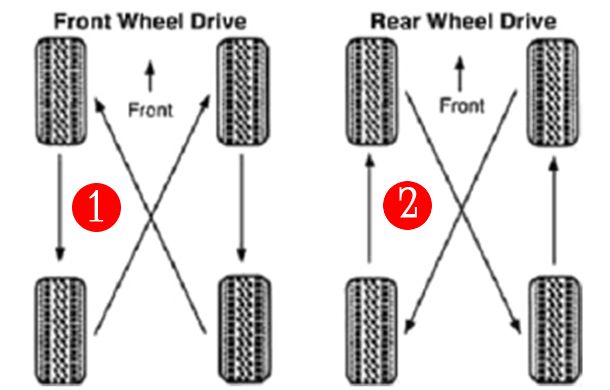 Doing so will ensure that, when stored properly, the tire will meet the definition of a new tyre.
Doing so will ensure that, when stored properly, the tire will meet the definition of a new tyre.
It should be noted that the warranty shelf life is not the service life of . The storage period for five years is set, not because the tire will deteriorate after that, but because, according to the law, the manufacturer does not have the right to establish a shorter warranty period, which is protection for the end user.
In recent years, many American experts believe that the shelf life and operation of car tires should be limited to 10 years. In turn, German experts believe that the expiration date of tires should be limited to 6 years, this also applies to new tires.
Rules and regulations for the storage of pneumatic tires according to GOST 24779-81:
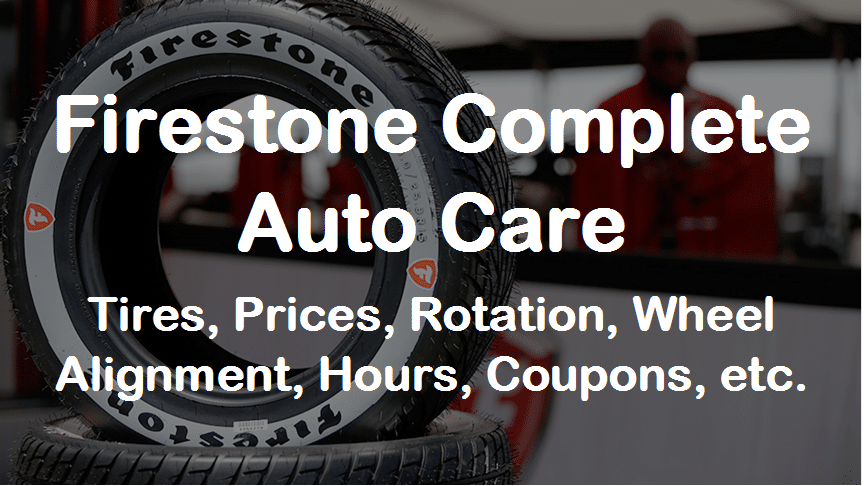
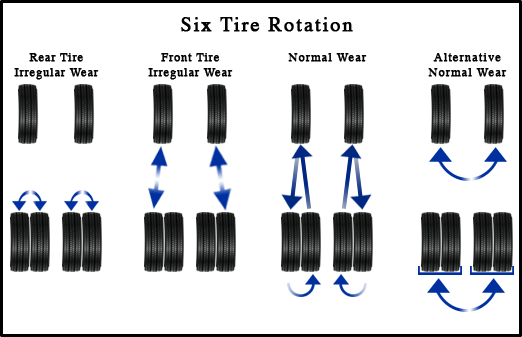
For a complete list of rules and recommendations for proper tire storage, see the article “How to store car tires”.
Well-known brands of imported tires, such as: Bridgestone, Michelin, Goodyear and Dunlop last up to 10 years or more from the date of manufacture, this period is generally accepted throughout the world. But the total shelf life and storage in the warehouse, from the date of issue, tires Continental is no more than 5 years.
Although, as we have already figured out, the storage conditions of tires mean a lot, not only new ones, but also those that were removed from the car until the next season.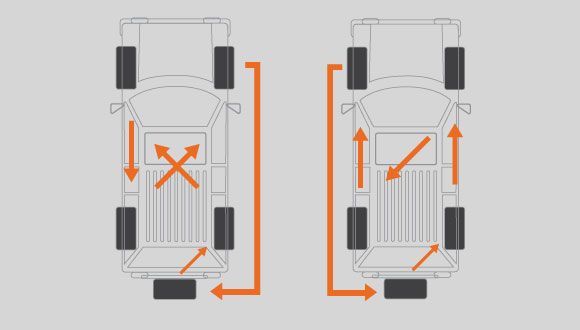 For example, nokian 9 tire expiration date0016 ranges from 3-5 years, subject to verification at least 1 time per year, after 5 years of use.
For example, nokian 9 tire expiration date0016 ranges from 3-5 years, subject to verification at least 1 time per year, after 5 years of use.
Unfortunately, the legislation does not establish the permissible storage periods for tires in a warehouse, but experts believe that a tire that has lain there for about 5 years is still equal to a new one.
The tire life of a vehicle is the period of time during which the manufacturer gives a guarantee for tires and is fully responsible for any defects that will be detected during their operation. According to manufacturers, tires should last at least ten years, although in practice they have to be replaced approximately every 5-6 years, in some cases even less.
There are many different factors that affect the wear of car tires, the main ones are listed below:
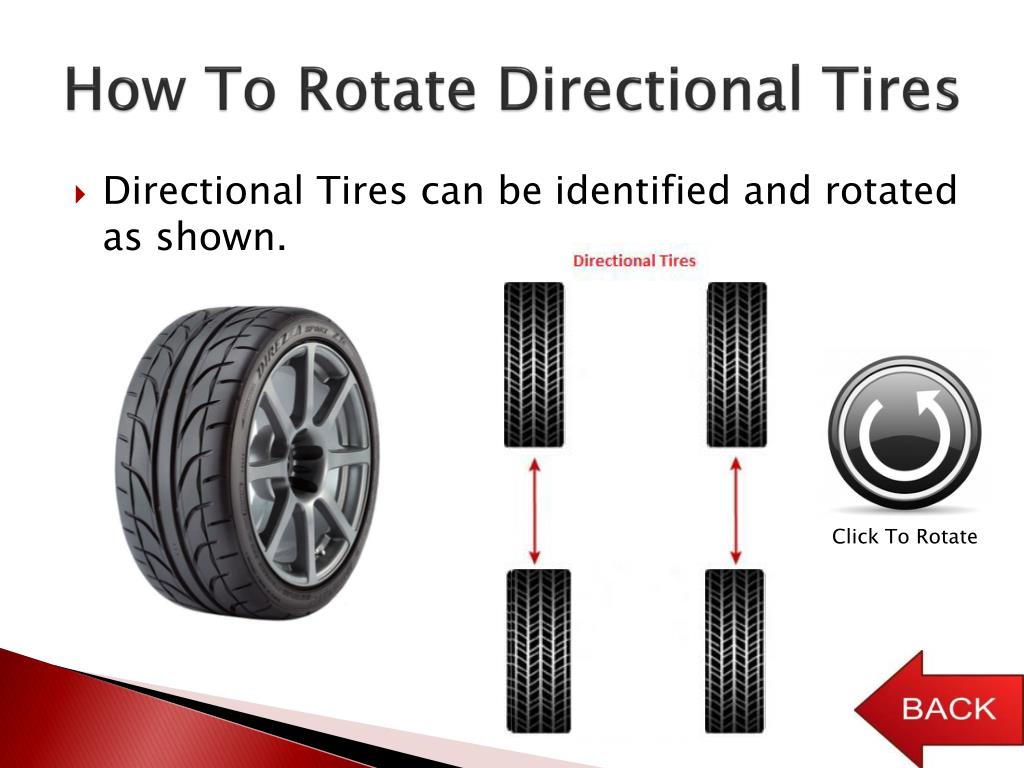 Please note that depending on this parameter, there are certain norms for the mileage of car tires on the roadway:
Please note that depending on this parameter, there are certain norms for the mileage of car tires on the roadway: 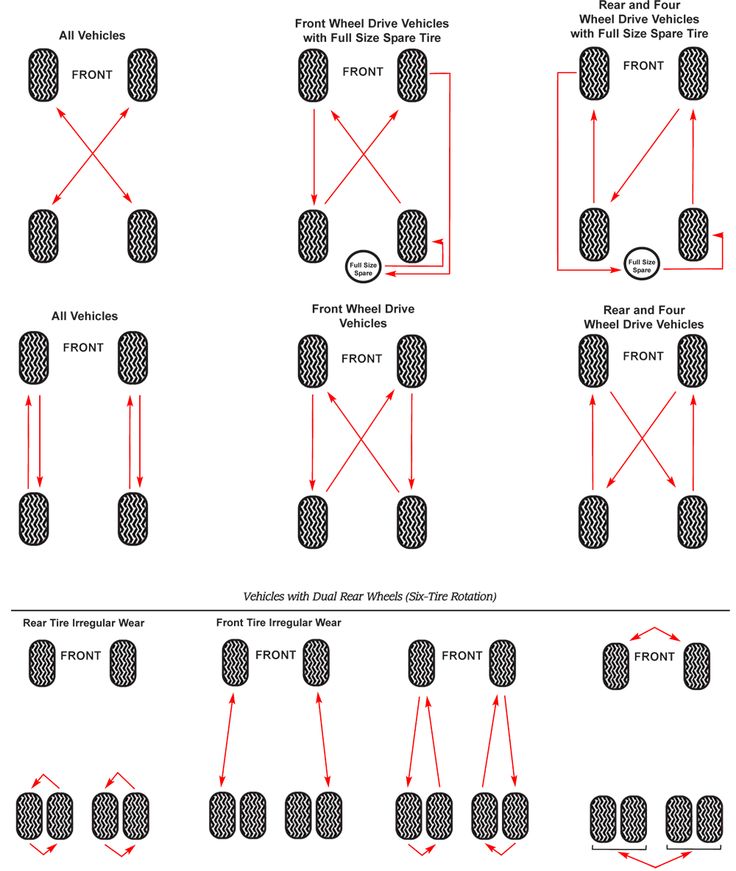 It is known that the service life of Chinese rubber is about two seasons, and branded rubber can last about seven years. When choosing tires, you need to pay attention to the manufacturer, because fakes are often sold under well-known brands.
It is known that the service life of Chinese rubber is about two seasons, and branded rubber can last about seven years. When choosing tires, you need to pay attention to the manufacturer, because fakes are often sold under well-known brands. Next, let's take a closer look at the instructions for certain actions that need to be taken in case of wear on car tires.
When diagnosing tires, in addition to the fact that it is imperative to pay attention to the degree of wear, there are also other equally important factors indicating the end of the service life.
In order to determine when the service life of car tires ends with a detailed inspection, you need to pay attention to the following points:
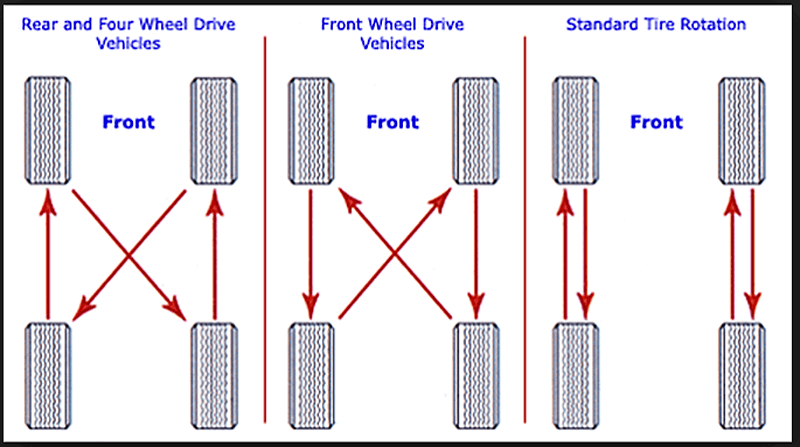 The degree of wear can be determined by eye or with the help of tools. On the outside, the tire surface has numbers with different depths, so you can easily determine the degree of wear. In order to measure the tread height, you can use a ruler with a special depth gauge. For summer tires, this parameter should be equal to more than 1.6 mm, in turn, for winter tires - more than 4 mm. If these parameters are less, then it is necessary to replace the tires. When the wear is uneven, then measurements should be taken in the area where the wear is most visible. Otherwise, if the tread edge is worn on only one side, then the camber-toe angle has been violated.
The degree of wear can be determined by eye or with the help of tools. On the outside, the tire surface has numbers with different depths, so you can easily determine the degree of wear. In order to measure the tread height, you can use a ruler with a special depth gauge. For summer tires, this parameter should be equal to more than 1.6 mm, in turn, for winter tires - more than 4 mm. If these parameters are less, then it is necessary to replace the tires. When the wear is uneven, then measurements should be taken in the area where the wear is most visible. Otherwise, if the tread edge is worn on only one side, then the camber-toe angle has been violated.  Also, such “hernias” can appear on the inside of the wheel, so you need to be extremely careful and inspect in time.
Also, such “hernias” can appear on the inside of the wheel, so you need to be extremely careful and inspect in time. When any defects were noticed in the tires, it is recommended to carry out a replacement, and not a rescue restoration, in order to at least somehow delay the period of use.
To prolong the life of car tires, it is necessary to periodically diagnose them.
In order to make your tires last longer, you need to follow certain rules of use:
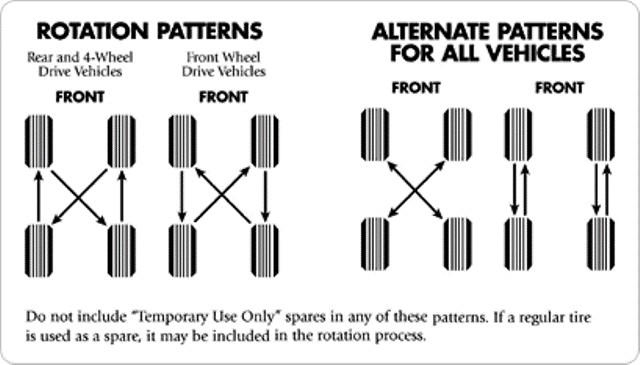 If the internal pressure is reduced by 10%, then this can lead to a 10-15% reduction in tire life. If the pressure is increased, then the wear also increases, but 2 times less than in the reduced one.
If the internal pressure is reduced by 10%, then this can lead to a 10-15% reduction in tire life. If the pressure is increased, then the wear also increases, but 2 times less than in the reduced one. Since there is always more wear on the front (driving) wheels, then every 10-15 times. thousand or at the time of changing seasonal tires, it is advisable to change it in places.
Swapping front tires to rear tires
Scheme of swapping 5 car wheels
Please note that although there are tires with directional and non-directional patterns, you still cannot change the direction of rotation of the wheel. And in the second option, the front wheels must be reboarded before being installed back.
It is necessary to check if the tires are correctly installed in relation to the rims, which is usually indicated on the sidewalls of the tires, this is important, since if the tires rotate in the opposite direction to the design, all their performance will be significantly reduced in all modes of operation of the car.
Non-directional tire replacement scheme
All-wheel drive tire replacement scheme
